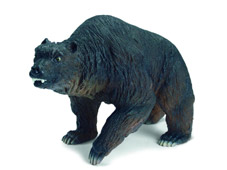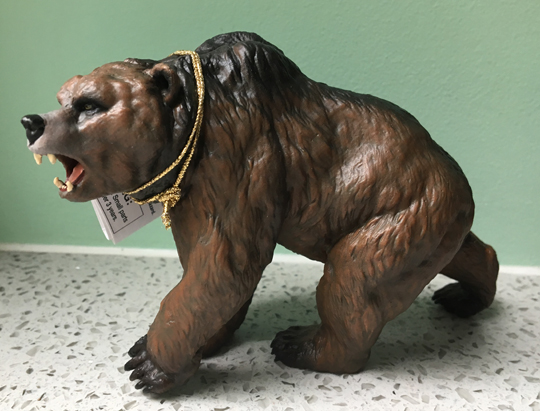New Research Reinforces Believe that Cave Bears were Omnivores
A new study into the feeding habits of Cave Bears indicates that many of them were not just gentle vegetarians snacking on roots, leaves and berries – meat was very much on the Cave Bear menu.
The Cave Bear (Latin name Ursus spelaeus) was a large relative of the modern Brown Bear that lived in central and southern Europe during the Pleistocene Epoch. Males could reach lengths in excess of 2.2 metres and when rearing up they could stand over 3 metres tall. These heavy set bears could reach weights of approximately 1,000 kilogrammes. The Cave Bear is so called because of the huge amount of bones and other remains that have been found inside cave systems. These bears seem to have hibernated in groups, using caves as shelter. Many bears did not survive the winter hence these sites provide scientists with a large number of fossil bears to study. One cave in Austria, known locally as the “Dragons Cave” has produced the remains of over 30,000 individuals. Scientists believe that this cave was used for thousands of years by Cave Bears as a hibernation chamber.
Ursus spelaeus – The Cave Bear

Picture credit: Everything Dinosaur
The picture above depicts a model of a Cave Bear, one of a series of hand painted prehistoric animal models in 1:20 scale.
To view prehistoric animal models: Dinosaur and Prehistoric Animal Models.
Cave Bears
It had been thought that these bears were omnivores, eating a wide variety of food like their close cousins the modern Brown Bear, now new research to be published in the online Proceedings of the National Academy of Sciences confirms that at least in some bear populations meat was a very important part of their diet.
The study, carried out by an international team of researchers, anthropologists and palaeontologists focused mainly on one group of Cave Bear finds from a site in the Carpathian mountains in Romania. By examining the type of nitrogen isotopes formed in the bone protein of Cave Bear fossils, scientists are able to determine the diet of these animals. Carnivores build up levels of the nitrogen isotope N-15 in their bones whilst vegetarians have low levels of this particular isotope. The greater the proportion of N-15 the greater the importance of meat in the diet.
Earlier studies into groups of bears found elsewhere in Europe had concluded that the modest to low levels of N-15 in bone protein indicated that these animals were mostly vegetarian. Now the research into this particular population from the Peştera cu Oase site (the name means “cave with bones” ) in Romania points to these bears being more carnivorous than previously thought due to the large amounts of N-15 found in their bone protein.
Formidable Predators
Cave Bears would have been formidable predators, like modern Grizzly Bears (a sub-species of the Brown Bear), they would have been capable of a turn of speed to help them chase down prey. Cave Bears would have been serious competition for prey resources amongst the other hunters around at the time – wolves, lions, hyenas and of course humans.
This particular site, discovered in 2002 has yielded some fascinating glimpses into our ancestors relationships with Cave Bears and with Neanderthals. Some of the Cave Bear bears seem to have been placed on raised rocks, this is not a natural location for a fossil. It has been speculated that Stone Age man worshipped Cave Bears and the bones may have been placed in an elevated position deliberately by early humans as an act of reverence. Throughout Europe many shrines and carved relics have been identified. Perhaps the competition for prey animals coupled with the competition for caves as shelters led our ancestors to have a great respect for these powerful animals.
Prehistoric Animal Models
Several replicas of Cave Bears have been made. For example both Schleich and Papo have added models of Ursus spelaeus to their ranges.
The Papo Cave Bear Replica
Picture credit: Everything Dinosaur
The range of prehistoric mammal figures including models of Cave Bears stocked by Everything Dinosaur can be viewed here: Models of Prehistoric Mammals.
This new research into the dietary habits of Cave Bears has involved Professor Erik Trinkaus (Professor of Anthropology at Washington University – St Louis). He has worked on a number of projects involving material from the Peştera cu Oase site, including studies into the human remains found in the cave system. Some of the remains exhibit both human and Neanderthal characteristics perhaps evidence of cross breeding between the two populations.







Leave A Comment